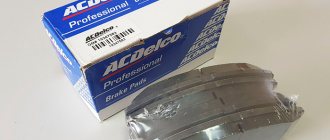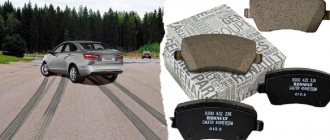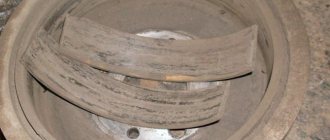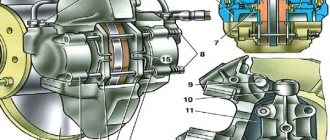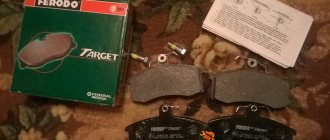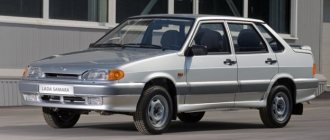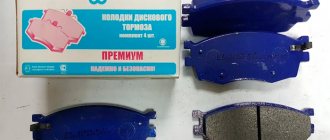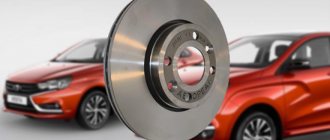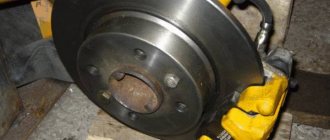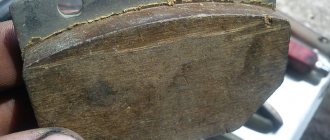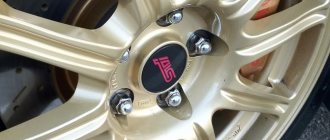Brake pads are the most important element of the braking system. The effectiveness of the brakes depends on them. Good, correct pads will not only perform their functions for a long time and reliably, but will also keep the brake disc or drum safe and sound for many years. On the contrary, bad, low-quality pads can ruin the brake disc by making deep grooves in it, etc.
Brake pads for disc brakes
Brake pads are different. Moreover, we are not talking about the structure and design, but primarily about the material of the friction linings, which actually perform the braking. Today there are a great variety of friction mixtures. Each company has its own recipe and ingredients. The mixture may contain 15 or more different components. Their proportions are clearly maintained. Any change in the proportion of one or another component can significantly change the properties of future brake linings, up to their complete inoperability.
The basis of the friction mixture is the reinforcing component. The strength, heat resistance and stability of the braking properties of the product depend on it. In recent years, stable types of friction products have emerged, which received their name precisely based on their reinforcing component. Asbestos, non-asbestos and organic (based on organic fibers) components are distinguished.
The first, as the name implies, use asbestos as a reinforcing element. The harmfulness of this material to humans has already become the talk of the town. Many car repair and maintenance manuals say that changing asbestos-containing brake pads and even removing wheels (if you have such brakes) must be done with extreme caution, taking care of respiratory and eye protection in advance.
Non-asbestos is a friction material in which the role of a reinforcing component is performed by other components. This could be steel wool, copper, brass shavings, various polymer compositions, etc. In budget pads, manufacturers use a mixture of organic and inorganic fibers, balancing between the coefficient of friction, wear resistance and the final price of the pad. If we are talking about expensive pads, although intended for road cars, then manufacturers can include granules of soft metals and artificial graphite, Kevlar and carbon fibers, thereby increasing the thermal stability of the friction material.
The most modern friction materials at the moment are based on organic fibers. These pads have the best braking properties. It is not for nothing that they are installed on modern Formula 1 cars, where the load on the brakes (by the standards of city cars) is simply prohibitive. After all, they have to reduce the speed of the car from 300 to 60 km/h in a matter of seconds or even a fraction of a second. Unfortunately, like any high-tech and knowledge-intensive products, the cost of such pads is affordable only for such “money” types of motorsport.
And let's remember the warmth again. The pads must also be cooled, but, unlike discs, they must not allow heat to pass through themselves. As they heat up, they will certainly begin to heat the working brake cylinders, and they, in turn, warm the brake fluid, and if it boils, the brakes will stop working, with all the ensuing consequences. This is why it is so important to provide a thermal barrier between the friction linings and the metal base of the brake pad.
What are car brake pads
The brake pad is a replaceable part of the caliper. It looks like a metal plate with a friction lining on it. The part is directly involved in slowing down the speed of transport. There are two types of pads:
- For disc brake system;
- For drum brake system.
Depending on the modification of the brakes, the pads either compress the disc or rest against the walls of the drum. Cars can use different types of braking systems. Often there are options when the contours of the line into which the brake fluid is pumped are divided into front and rear.
In such cars, when you press the brake pedal, the front calipers are activated first, and then the rear ones. For this reason, drum pads are replaced less frequently than front pads.
In addition to the key classification, these products differ from each other in functionality:
- The kit may also include a wear sensor, which is connected to the vehicle's on-board electrical system. Since the pads in any car are subject to wear, the sensor notifies the driver of the need to replace the part.
- The brake element has a mechanical wear indicator. A characteristic creaking noise allows the driver to determine that the elements are worn out and need to be replaced. This type of pads has a lower cost compared to the previous modification.
If the car uses a combined braking system, then the front element in this case will be disc, and the rear element will be drum. This type of system is installed on budget cars. A more expensive car is equipped with all-round disc brakes.
Lamps used on Geely MK / Geely MK
Published: 07/21/2019
Spread the love
Spread the love Lamps for Geely MK Used lamps for a Geely MK car produced in 2006-2014. — H1 halogen lamp with a power of 55 watts. Small, elongated size with one electrical contact. — H1 halogen lamp with a power of 55 watts. Small, elongated size with one electrical contact. - H3 halogen lamp...
Lamps used on Geely MK / Geely MK Read more »
What affects braking?
The car stops due to the action of the pad on the disc mounted on the wheel hub. The friction coefficient of the replacement pad plays a key role in this. Naturally, the higher the friction, the more clearly the brakes will operate.
In addition to system response and braking efficiency, this characteristic directly affects the effort that the driver must apply to the brake pedal in order for the vehicle to begin to slow down.
The value of the friction coefficient is influenced by the material from which the friction surface is made. This determines whether the brakes will be soft and precise or whether the pedal will need to be pressed hard so that the wheels slow down.
Types of brake pads
As mentioned earlier, all pads are divided into two types: for installation in drums (rear wheels, and in older cars they were installed in the front) or on discs (front wheels or in a more expensive model of vehicle - in a circle).
The peculiarity of the drum brake system is that the design of the mechanism allows the use of a large contact area to increase the friction force during brake activation. This modification is more effective on trucks, since the truck is often heavy, and disc brakes in this case will have too small a contact surface.
To increase efficiency, it will be necessary to install an additional support, which is not economically profitable. The advantage of this modification is that the vehicle manufacturer can freely increase the width of the drum and pads, which will increase the reliability of the brakes. The disadvantages of drum vehicles are that they are poorly ventilated, which is why they can overheat during a long descent. Also, the drum can wear out faster, since all the debris resulting from the wear of the pad remains inside the mechanism.
As for the disc modification, the pads and disc in them are better ventilated, and the entry of dirt and moisture into such brakes is not critical for transport. The disadvantage of this modification is that the contact area can be increased by installing a disk with an increased diameter, and, accordingly, larger calipers. This is a disadvantage, since not every wheel allows such an upgrade.
The effectiveness of the pads depends on the friction lining. For this, manufacturers use different materials. Here is their main classification.
Organic brake pads
The friction layer of such parts includes various materials of organic origin. It can be rubber mixed with glass, fiberglass, carbon compounds, etc. Such elements have a minimum content of metal components (no more than 20 percent).
Pads with organic linings will cope perfectly with moderate driving of a passenger car. At low speeds, a slight pressure on the brake pedal is enough to activate them.
The advantages of these modifications include softness and quietness during braking. This property is ensured by the minimal presence of abrasives. The disadvantages of such pads are their significantly shorter working life compared to other analogues. The friction layer in them is soft, and therefore wears out much faster.
Another disadvantage of organic pads is that they do not tolerate high heat. For this reason, they are installed on budget vehicles, which are not particularly powerful. Most often, such elements will be installed on small cars.
Semi-metallic brake pads
This category of pads will have a higher quality friction layer. They are used in most cars in the budget and mid-price segment. The lining of such a block will consist of metal (up to 70 percent depending on the manufacturing technology). The material is bonded with a composite substance, which gives proper strength to the product.
This modification is widely used in mechanical means. These pads will be equipped in a passenger car, crossover, small truck, van, SUV or car participating in amateur sports competitions.
The advantages of semi-metallic linings include an increased working life (compared to an organic analogue). This layer also has a high coefficient of friction, withstands intense heat and cools quickly.
The disadvantages of such products include the formation of more dust (more information on how to remove graphite deposits from transport disks is described here ). Compared to their organic counterparts, semi-metallic pads produce more noise during braking. This is due to the fact that it will contain a large number of metal particles. To operate effectively, the pads must reach operating temperature.
Ceramic brake pads
The price of such pads will be higher than all those listed earlier. This is due to the fact that their quality is much higher. Ceramic fiber is used as a friction layer in these elements.
The advantages of ceramic pads are excellent responsiveness of the brake pedal. They have a wide range of operating temperatures, although their efficiency in cold temperatures is low. They do not contain metal particles, so these brakes do not make much noise during operation. Ideal for sports cars.
Despite the obvious advantages over the linings mentioned above, the ceramic analogue is not intended for installation on slow transport. They are especially not recommended for use in trucks and SUVs.
So that the motorist can independently determine what material is used to make the pads, manufacturers apply special markings. Markings can be colored or lettered.
The color classification indicates the maximum permissible temperature. This parameter is as follows:
- Black color - used in regular budget cars, as well as models in the mid-price segment. Ideal for daily travel. The product will be effective if it heats no more than 400 degrees.
- Green friction layer - overheating is allowed to a maximum of 650 degrees.
- Red trims are already products for entry-level sports cars. The maximum permissible overheating is 750 Celsius.
- Yellow block - used on professional racing vehicles that participate in events such as circuit racing or track racing. Such brakes are able to maintain their effectiveness up to temperatures of 900°C. This temperature range may be indicated by blue or light blue.
- The orange pad is used only in highly specialized racing vehicles, the brakes of which can heat up to one thousand degrees.
On each pad, in addition to information about the manufacturer and certification, the company can indicate the friction coefficient. This will be a letter sign. Since this parameter changes depending on the heating of the lining, the manufacturer can apply two letters. One indicates the coefficient of friction (CT) at a temperature around 95°C, and the second - about 315°C. This marking will be located next to the catalog number.
Here are the parameters each character corresponds to:
- C – CT up to 0.15;
- D – CT from 0.15 to 0.25;
- E – CT from 0.25 to 0.35;
- F – CT from 0.35 to 0.45;
- G – CT from 0.45 to 0.55
- N – CT from 0.55 or more.
Having basic knowledge about this marking, it will be easier for the driver to choose the right quality pads suitable for specific operating conditions.
Classification by “price-quality”
Since each manufacturer uses its own friction mixtures, it is extremely difficult to indicate which lining will be better. There is a wide variety of them, even within the products of one manufacturer.
Each product group is suitable for different classes of cars. A cheap block may be installed in a car at the factory, but in addition the car owner can buy a more reliable analogue, which will allow the vehicle to be used in more severe conditions.
Conventionally, friction linings are divided into three categories:
- Highest (first) class;
- Middle (second) class;
- Lower (third) class.
The first class category includes so-called original spare parts. Most often, these are products that are manufactured by a third-party company for a well-known brand. Its products are used on assembly lines.
It happens that the automaker receives better quality pads than those that go on the auto parts market. The reason for this is preliminary heat treatment. To ensure that a car leaving the production line meets the certification requirements, the brake pads are “burned.”
In auto parts stores, under the “original” label, an analogue with a simpler composition and without pre-treatment will be sold. For this reason, there is not much difference between the original spare part and a similar one sold by another well-known brand, and new pads need to be “ground in” over a period of approximately 50 km.
Another difference between “conveyor” products and similar ones sold in car dealerships is the difference in the friction coefficient and their working life. Cars that come off the assembly line have brake pads with a higher CT, but they last less. As for analogues sold on the auto parts market, they have the opposite - the CT suffers, but they wear out longer.
Products of the second class are of lower quality compared to the previous ones. In this case, the company may deviate slightly from the manufacturing technology, but the product complies with the certification. The designation R-90 is used for this. Next to this designation is the number of the country (E) in which the certification was carried out. Germany corresponds to the number 1, Italy – 3, and Great Britain – 11.
Second class brake pads are in demand because they have an ideal price/quality ratio.
It is completely logical that third-class products will be of worse quality than the previous ones. Such pads are produced by small enterprises, which may be part of the production group of a particular car brand, or may be separate small companies.
When purchasing such pads, the motorist acts at his own peril and risk, as this affects the safety of the vehicle when emergency braking is required. In one case, the friction lining may wear unevenly, and in another, it can be so hard that the driver’s foot quickly gets tired when pressing the pedal frequently.
Wiper wiper sizes for Kia Optima/KIA Optima 2018
Published: 02/26/2020
Spread the love
Spread the love Wipers for Kia Optima/KIA OptimaContents1 Wipers for Kia Optima/KIA Optima1.0.1 Which wipers are better for Kia Optima/KIA Optima1.0.2 Frame wipers for Kia Optima 3rd generation1.0.3 Frame blades for Kia Optima 41.0.4 Replacement wipers Kia Optima / KIA Optima Wiper blades for Kia Optima from 2010-2021 Size of wipers Kia Optima: [2010-2016]-[2016-2020] Which wipers are better for ...
Size of wipers on Kia Optima/KIA Optima 2022 Read more »
What types of manufacturers are there?
Before buying pads, you should pay attention to its packaging. An ordinary cardboard box without identification marks is a reason for concern, even if it shows a familiar label. A manufacturer who cares about its name will spare no expense on quality packaging. It will also display the certification mark (90R).
Brake pads from the following companies are popular:
- Most often, the Brembo inscription causes admiration among motorists;
- Ferodo produces good pads for amateur sports competitions;
- ATE brand pads are considered premium products;
- Bendix is a world-famous manufacturer of high-quality braking systems;
- The best option for urban mode can be chosen among the products sold by Remsa;
- The German manufacturer Jurid uses advanced technologies in production, making its products popular among car enthusiasts;
- Pagid produces assembly line products for the assembly of cars such as the Volkswagen Golf, Audi TT and Q7, as well as some Porsche models;
- For lovers of a sporty driving style, there are reliable products manufactured by the Textar brand;
- Another German manufacturer that produces not only high-quality brake pads, but also a variety of all kinds of equipment is Bosch;
- Although Lockheed primarily manufactures aircraft engines, the manufacturer also offers high-quality brake pads;
- If you bought a new car, you can replace the standard elements with analogues from Lucas/TRW.
Pad wear and brake disc wear
Brake pad wear depends on many factors. The very first one is product quality. We have already considered this issue. The second factor is the weight of the vehicle. The higher it is, the greater the friction coefficient should be for the friction part of the part, since the inertia force of such a car is high.
Another factor that can sharply reduce or, on the contrary, increase the working life of the pads, is the driver’s driving style. For motorists who mostly drive slowly and do not brake sharply, these parts can last 50 thousand kilometers or more. The more often the driver presses the brake, the faster the friction lining wears out. This element also wears out faster when defects appear on the disc.
While a brake pad (especially a cheap, low-quality one) can fail abruptly, in the case of a disc this happens more predictably. Under normal operating conditions, this part remains in good condition until the vehicle owner replaces 2 sets of pads. When the disc wears two millimeters, it needs to be replaced with a new one. This parameter can be determined by the height of the chamfer formed on the part.
Some people check the condition of the disc by touch by sticking their hand between the spokes of the wheel, but it is better to remove the wheel completely for this procedure. The reason for this is possible increased surface wear on the inside of the part. If wear has appeared on the disc, but the pads have not yet worn out, then replacing the first part can be postponed for a while, especially if the driver drives steadily.
As for drum brakes, they wear out much more slowly, but they also develop wear. Without removing the drum casing, the condition of the contact surface is almost impossible to assess. If the thickness of the drum walls has worn out by one millimeter, it is time to change it.
Operational Requirements
All this is due to high requirements for the quality of the product. Brake linings function in very difficult and aggressive conditions. Therefore, they must not only have good friction, but also provide effective and safe braking in critical conditions:
- with sudden changes in temperature;
- increased contamination and dustiness of the mechanism;
- ingress of water and various chemically destructive substances.
At the same time, friction linings reduce the noise level during friction against the brake disc or drum. If the quality of the lining material is poor, then when braking, a characteristic squeaking, unpleasant, loud sound is produced, which almost every person on the roadway has heard.
When should you change your brake pads?
Typically, car manufacturers indicate such a replacement period - from 30 to 50 thousand kilometers traveled (unlike the oil change interval , this parameter depends specifically on the mileage). Most motorists replace these consumable parts regardless of whether they are worn out or not.
Even if the car owner’s financial resources are limited, it is not recommended to buy cheap products, since the health and safety of not only the driver and his passengers, but also other road users depends on these elements.
Diagnostics
The condition of the brake pads can be determined by several characteristic factors. Before you “sin” on the brakes, you should first make sure that all wheels have the correct tire pressure (when the car brakes, a discrepancy in pressure in one of the tires can manifest itself identically to brake failure).
Here's what to look for when pressing the brake pedal:
- When the brake is pressed sharply, a beating sensation is felt in the pedal. This can happen, for example, when you press lightly when approaching a traffic light. With use, the friction layer on all pads wears unevenly. The element on which the lining is thinner will create runout. This may also indicate uneven disc wear.
- When the pad is maximally worn, it squeaks loudly when it comes into contact with the disc. The effect does not disappear after several presses of the pedal. This sound is produced by a special signal layer, which is equipped with most modern overlays.
- Friction lining wear can also affect pedal feel. For example, the brakes may become harder or, on the contrary, softer. If you have to put in more effort to press the pedal, then you should definitely pay attention to the pads. In the event of sudden wheel locking, replacement should be carried out as soon as possible, as this can often be a sign that the lining is completely worn out and metal is already in contact with metal.
- The presence of a heavy coating of graphite mixed with metal particles on the wheel rims. This indicates that the friction layer has worn out and wear is forming on the disc itself.
These diagnostic actions are indirect. In any case, without removing the wheels, and in the case of drums, without completely disassembling the mechanism, it is impossible to fully assess the condition of the brakes. It’s easier to do this at a service center, where specialists will also check the entire system.
To conclude the review, we offer a short video comparison of some types of pads for budget cars:
Which brake pads are best for cars?
General provisions
Brake pads are consumables, their cost is low, and replacement can be done with your own hands. All this is correct in relation to passenger cars. For trucks, purchasing and replacing brake pads becomes a rather labor-intensive and expensive procedure. In this regard, in order to reduce operating costs and ensure traffic safety when transporting goods and passengers, the process of replacing brake linings is carried out. In professional language, such linings are called friction linings.
They are attached to the block using rivets, and in the case of using non-freight light-duty passenger vehicles, it is possible to install the lining using a special adhesive.
They are made of composite materials and are located directly on the brake pads.
